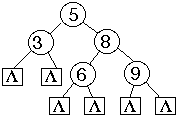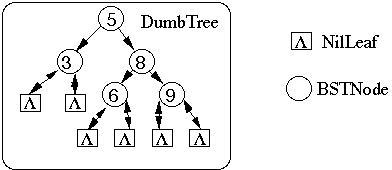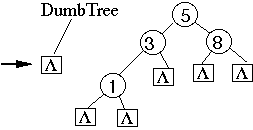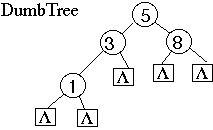
Fall Semester, 2000
Distributing System Intelligence
© 2000, All Rights Reserved, SDSU & Roger Whitney
San Diego State University -- This page last updated 18-Sep-00

|
CS 535 Object-Oriented Programming & Design Fall Semester, 2000 Distributing System Intelligence |
|
|---|---|---|
|
© 2000, All Rights Reserved, SDSU & Roger Whitney San Diego State University -- This page last updated 18-Sep-00 |
Distributing System Intelligence
A Tree Example
Problem:

Solution 0 SmartTree, StructNode
StructNode class StructNode { public StructNode left = null; public StructNode right = null; public int key; public Object value; }
Solution 1 SmartTree, DumbNode
DumbNode class DumbNode { protected DumbNode left = null; protected DumbNode right = null; protected int key; protected Object value; public DumbNode( int key, Object value ) { this.key = key; this.value = value; } }
SmartTree Fields package sdsu.trees; import java.util.*; public class SmartTree { protected DumbNode root = null; // Methods shown later }
Since everyone has implemented a tree search I do not show put and get methods
SmartTree MethodsPreorder Traversal 1) Print "(" then Visit left subtree
2) Print node
3) Visit right subtree, then print ")"

Applying rule we get:
( left subtree 5 right subtree ) ( (3) 5 ( left subtree 8 right subtree ) ) ( (3) 5 ( (6) 8 (9) ) )
SmartTree MethodstoString() Helper Class
The following three pages implement a standard algorithm to perform a preorder traversal of a binary tree. Check any data structures text. You will find this implementation in the book. The point is to show how long and complex this is. You do not have to understand it.
Need to store path of nodes visited on a stack with which visit we are on: first, second or third
public class TraversalInfo { public DumbNode node; public int visitNumber; public TraversalInfo( DumbNode nodeTraversed, int visitNumber ) { node = nodeTraversed; this.visitNumber = visitNumber; } }Constants for toString()
private final static int FIRST = 1; private final static int SECOND = 2; private final static int THIRD = 3;
SmartTree MethodstoString(): Simple Algorithm public String toString() { StringBuffer treeString = new StringBuffer(); TraversalInfo currentLocation; Stack visited = new Stack(); visited.push( new TraversalInfo( root, FIRST ) ); while ( visited.empty() != true ) { currentLocation = (TraversalInfo) visited.pop(); switch ( currentLocation.visitNumber ) { case FIRST: treeString.append( "(" ); firstVisit( visited, currentLocation ); break; case SECOND: treeString.append( currentLocation.node.key ); secondVisit( visited, currentLocation ); break; case THIRD: treeString.append( ")" ); break; } } return treeString.toString(); }
SmartTree MethodstoString(): continued protected void firstVisit( Stack visited, TraversalInfo currentLocation ) { DumbNode nextnode; currentLocation.visitNumber = SECOND; visited.push( currentLocation ); if ( currentLocation.node.left != null ) { nextnode = currentLocation.node.left; visited.push( new TraversalInfo( nextnode, FIRST ) ); } } protected void secondVisit( Stack visited, TraversalInfo currentLocation ) { DumbNode nextnode; currentLocation.visitNumber = THIRD; visited.push( currentLocation ); if ( currentLocation.node.right != null ) { nextnode = currentLocation.node.right; visited.push( new TraversalInfo( nextnode, FIRST ) ); } }
Solution 2 DumbTree, BSTNode
1) Let the nodes do some work 2) Add some nil leaves to eliminate some cases
Class StructureInheritance

Runtime Structure

Preorder Traversal - Basic Idea
BSTNode
Get the preorder of left subtree, right subtree,
Put key in middle
public String toString() { return "(" + left.toString() + key + right.toString() + ")"; }
NilLeaf
Represents an empty node
Action is to do nothing
public String toString() { return ""; }
DumbTree
package sdsu.trees; public class DumbTree { protected TreeNode root = null; public Object get( int key ) { if ( root == null ) return null; return root.getNode( key ).value(); } public Object put( int key, Object value ) { if ( root == null ) { root = new BSTNode( key, value ); return null; } return root.getNode( key ).put( key, value ); } public String toString() { return root.toString(); } }
TreeNode
abstract class TreeNode { /** * Puts the specified key & value in this node */ abstract public Object put( int key, Object value ); /** * Return the value of the TreeNode */ abstract public Object value(); /** * If keyToFind is in the subtree rooted at this node, then return * node containing keyToFind. * Otherwise return the NilLeaf that should contain keyToFind */ abstract public TreeNode getNode( int key ); /** * Return an ascii representation of tree rooted at this node */ abstract public String toString(); }Comments
There is no common code or methods between BSTNode and NilLeaf
TreeNode could be either an interface or an abstract class
BSTNode
class BSTNode extends TreeNode { protected TreeNode left; protected TreeNode right; protected int key; protected Object value; public BSTNode( int key, Object value ) { this.key = key; this.value = value; left = new NilLeaf( this ); right = new NilLeaf( this ); } /** * Return the value of the TreeNode */ public Object value() { return value; } /** * Return an ascii representation of tree rooted at this node */ public String toString() { return "(" + left.toString() + key + right.toString() + ")"; } Note how simple the toString() method is here!
BSTNode Continued public Object put( int keyToAdd, Object valueToAdd ) { Object oldValue = value; value = valueToAdd; return oldValue; } /** * If keyToFind is in the subtree rooted at this node, then return * node containing keyToFind. * Otherwise return the NilLeaf that should contain keyToFind */ public TreeNode getNode( int keyToFind ) { if ( keyToFind < key ) return left.getNode( keyToFind ); else if ( keyToFind > key ) return right.getNode( keyToFind ); else return this; } /** * Puts indicated key and value in proper child of this node */ protected void putAsChild( int keyToAdd, Object valueToAdd ) { if ( keyToAdd < key ) left = new BSTNode( keyToAdd, valueToAdd ); else if ( keyToAdd > key ) right = new BSTNode( keyToAdd, valueToAdd ); } }
NilLeaf
class NilLeaf extends TreeNode { protected BSTNode parent; public NilLeaf( BSTNode parent ) { this.parent = parent; } public Object put( int key, Object value ) { parent.putAsChild( key, value ); return null; } public Object value() { return null; } public TreeNode getNode( int key ) { return this; } public String toString() { return ""; } }
How Does this Work?
DumbTree example = new DumbTree(); example.put( 5, null ); example.put( 3, null ); example.put( 8, null ); // Now add a 1
// Now add a 1
example.put( 1, null ); // In DumbTree's put( 1, null ) method does: return root.getNode( 1 ).put( 1, null );
// in BSTNode with key 5 method getNode( 1 ) does: if ( 1 < 5 ) return left.getNode( 1 ); else if ( 1 > 5 ) return right.getNode( 1 ); else return this;
Example Continued

// in BSTNode with key 3 method getNode( 1 ) does: if ( 1 < 3 ) return left.getNode( 1 ); else if ( 1 > 3 )

// in NilNode method getNode( 1 ) does:
return this;

// in BSTNode with key 3 method getNode( 1 ) does: if ( 1 < 3 ) return left.getNode( 1 );
Example Continued

// in BSTNode with key 5 method getNode( 1 ) does: if ( 1 < 5 ) return left.getNode( 1 );

// In DumbTree's put( 1, null ) method does: return root.getNode( 1 ).put( 1, null );
// in NilNode method put( 1, null ) does: parent.putAsChild( 1, null ); return null;
Example Continued 
// in BSTNode with key 3 method putAsChild( 1, null ) does: if ( 1 < 3 ) left = new BSTNode( 1, null ); else if ( 1 > 3 )
// in NilNode method put( 1, null ) does: parent.putAsChild( 1, null ); return null;

// In DumbTree's put( 1, null ) method does: return root.getNode( 1 ).put( 1, null );
Comparison
| Metric | SmartTree | DumbTree |
| LOC[1] | 60 | 36 |
| Number of classes | 3 | 4 |
| Number of methods | 6[2] | 18[3] |
| LOC/method | 10 | 2 |
Issue Avoid Case (and if) Statements
Implementation that avoids if statements by sending a message to an object
NilLeaf returns a null string;
public String toString() { return "(" + left.toString() + key + right.toString() + ")"; }
Implementation that uses if statements
public String toString() { String treeRepresentation; treeRepresentation = "("; if ( left != null ) treeRepresentation = treeRepresentation + left.toString(); treeRepresentation = treeRepresentation + left.toString(); if ( right != null ) treeRepresentation = treeRepresentation + right.toString(); treeRepresentation = treeRepresentation + ")"; return treeRepresentation; }
Issues: Performance
Have you lost your mind?
DumbTree is slower than SmartTreePerformance Test
Insert ints from 1 to N into each tree
Look up each int once
Times are measured on a PowerMac 7100/80
Times are in milliseconds
Timing Results
| N -> | 400 | 800 | 1600 |
| SmartTree create | 264 | 1064 | 4342 |
| DumbTree create | 314 | 1290 | 5681 |
| SmartTree find all | 261 | 1049 | 4197 |
| DumbTree find all | 272 | 1193 | 5370 |
More Timing Results
| N -> | 400 | 800 | 1600 |
| SmartTree create | 264 | 1064 | 4342 |
| DumbTree create | 314 | 1290 | 5681 |
| DumbAVLTree create | 46 | 94 | 196 |
| Hashtable create | 42 | 82 | 165 |
| Opt. Hashtable create | 25 | 57 | 102 |
| SmartTree find all | 261 | 1049 | 4197 |
| DumbTree find all | 272 | 1193 | 5370 |
| DumbAVLTree find all | 11 | 23 | 50 |
| Hashtable find all | 30 | 61 | 127 |
| Opt. Hashtable find all | 14 | 27 | 54 |
[1]What is a line of code (LOC)? Do you count a "{" as a line of code? For this comparison I selected a method of counting made easy by my word processor: I counted the number of ";" in the code.
[2]Originally firstVisit and second visit methods did not exist. They were added just to make each method fit on one slide. Hence I did not count them as methods for this comparison.
[3]This includes the abstract class
Copyright ©, All rights reserved.
2000 SDSU & Roger Whitney, 5500 Campanile Drive, San Diego, CA 92182-7700 USA.
OpenContent license defines the copyright on this document.
Previous visitors since 18-Sep-00 Next